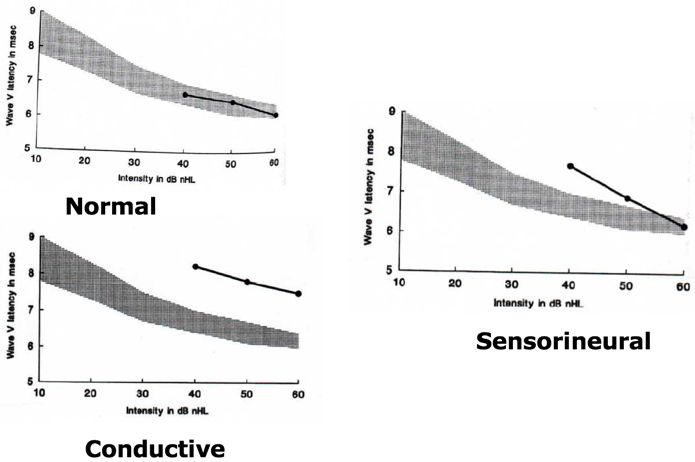Good Practices in Auditory Brainstem Response , Part Wendy. What is latency intensity for conductive hearing? Is latency-intensity normal? ABR) wave V latency-intensity function (LIF) in listeners with normal hearing or cochlear hearing loss. We attempted to find out the intrinsic reasons.
Result: Frequencies from 0. Hz have been tested and the thresholds of tone-burst ABR were recorded. Therefore, the latency increases by the time necessary for the travelling wave to reach the responding region. AP latency also depends on the intensity of the stimulus. The average thresholds.
These data demonstrate that as the stimulus intensity decreases, latency systematically increases. A schematic description of the correlation between various pathologies of hearing impairments and the behavior of auditory brainstem responses (ABR) is presented. Conductive pathology and high-frequency cochlear hearing losses prolong wave component latency due to energy loss and hair cell dysfunction.

This procedure may also prove useful for clinical evaluation of auditory function. There are different stimuli that we can use with the ABR , the most basic being the broadband click stimulus. These are very brief stimuli that trigger a rapi synchronous neural onset. See full list on audiologyonline. They illustrate how outer, middle, and inner ear dysfunction as well as auditory neuropathy and brainstem dysfunction influence the characteristics of the click-evoked ABR.
Honestly, we do not know. Because of her age, it is difficult to predict what is going to happen or what information she can utilize. Further evaluation, including ABR, would be in order. To date, we have not seen her back. In our clinic, our natural-sleep ABRs are scheduled for two hours.
By the time the baby is fe b. San Diego, CA: Singuluar Publishing. Imaging in Chiari II malformation. In the Chartr EP 2system, the normative data includes a mean and standard deviation. Michael Gorga of Boystown National Research Hospital.
There is limited data available on speech ABR , both in normal and pathological ears. Materials and Methods: Speech ABR was done using the standardized protocol on ears with moderate SNHL were chosen. ABR wave latencies in the brainstem auditory pathways. No correction is needed at dB. In addition, disorders causing dissynchronization of neural activity result in an amplitude decrease.

A individual with a steep high-frequency sensorineural hearing loss demonstrates a very-steep wave V latency-intensity function to clicks. In this chapter, using high-pass noise masking and. An ABR click latency - intensity function (LIF), ABR kHz tone LIF, and DPOAE kHz amplitude- intensity function (AIF) were recorded from each listener. A loudness- intensity function was also meas-ured for each electrophysiologic stimulus. Children and adults exhibited similar intensity functions of ABR latency , DPOAE amplitude, and loudness.
ABR is measured in microvolts (millionths of a volt) and the ASSR is measured in nanovolts (billionths of a volt). A delayed Wave V with normal Wave I latency signifies that the delay has occurred somewhere after Wave I (i.e., central to the auditory nerve).
No comments:
Post a Comment
Note: Only a member of this blog may post a comment.